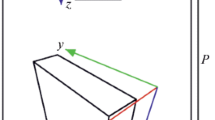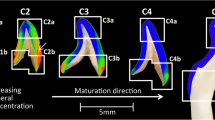Summary
The growing ends of rat incisors were freeze-dried and embedded in methacrylate without contact with any other solution. Dentine from alcohol and formalin fixed human teeth was also embedded in methacrylate. Ultrathin sections were prepared and electron micrographs taken at original magnifications of X20 000 and X40 000. The best focussed pictures from through focus series were selected for photographic enlargement to a total of X200 000. 507 measurements of the distance between dot-like nuclei in the calcium phosphate needles and chains and 536 measurements of the distance between the neighbouring parallel chains and needles were made using a measuring microscope. In addition, the most commonly occurring separation distances between the dot-like nuclei — within individual rows or between neighbouring rows—were measured by laser diffraction of the x20 000 EM negatives.
The most commonly occurring range for the distance between the dot-like nuclei and the lateral distance between the rows as determined morphologically was 3.7–6.3 nm. The corresponding value as determined by laser diffraction for the recently formed rat incisor dentine lay in the region 3.0–5.2 nm, whereas the same value reached to 6.5 nm in the case of mature human dentine. The distances between the dot-like nuclei are regarded as representing the distances between active nucleus-inducing centres on a chain-like matrix. From a study of the morphology of the nuclei it is concluded that the plate-like crystallites usually arise through fusion of needle-like rows of dot-like nuclei when these lie close and parallel to one another.
Zusammenfassung
Von neu gebildetem, gefriergetrocknetem Dentin in Rattenschneidezähnen und von alkohol- und formol-fixiertem, reifem menschlichen Dentin wurden Ultradünnschnitte bei Vergrößerungen 20 000∶1 und 40 000∶1 in Fokusreihen aufgenommen.Die gut fokussierten Aufnahmen des Ratten-Dentins wurden auf nichtschrumpfendem Photopapier und Diafilm-Material 20 0000∶1 nachvergrößert. Mit einem Meßmikroskop wurden 507 Abstände zwischen den punktförmigen Keimen in den Ca-Phosphat-Nadeln und -Ketten sowie 536 Seitenabstände zwischen dicht zusammenliegenden, parallel verlaufenden Nadeln und Ketten bestimmt. Außerdem konnten in beiden Dentin-Arten die am häufigsten auftretenden Abstände beider Abstandsarten durch Anwendung der Laserbeugung auf die bei 20 000∶1 aufgenommenen Filme erhalten werden. Die morphologisch bestimmten Punktkeimabstände und die Seitenabstände lagen vor allem im Bereich von 37–63 Å, die durch Laserbeugung erhaltenen Werte für das neugebildete Dentin im Bereich von 30–52 Å, während sie beim reifen menschlichen Dentin noch bis zu Werten um 65 Å reichten. Wie bei Höhling u. Mitarb. (1970) wurden die Punktkeimabstände als Abstände zwischen den akiven, keiminduzierenden Zentren auf einer kettenartigen Matrix diskutiert. Aus der Morphologie der Keime wurde ferner geschlossen, daß sich hier die blättchenförmigen Kristallite im allgemeinen durch Zusammenwachsen von Nadeln bilden, wenn diese dicht und parallel zusammenliegen.
Similar content being viewed by others
References
Appleton, J.: Ultrastructural observations on early cartilage calcification. The use of chromiumsulphate in decalcification. Calc. Tiss. Res. 5, 270–276 (1970).
Bocciarelli, D. St.: Morphology of crystallites in bone. Calc. Tiss. Res. 5, 261–269 (1970).
Bonucci, E.: Fine structure of early cartilage calcification. J. Ultrastruct. Res. 20, 33–50 (1967).
Buddecke, E., Kröz, W., Tittor, W.: Chondroitinsulfat-Protein aus Rindernasenknorpel-Beziehungen zwischen makromolekularen Eigenschaften und Funktion. Hoppe-Seylers Z. physiol. Chem. 348, 651–644 (1967).
Cameron, D. A.: The fine structure of bone and calcified cartilage. Clin. Orthop. 26, 199–228 (1963).
Eastoe, J. E.: Chemical organization of the organic matrix of dentine. In: Structural and chemical organization of teeth (A. E. W. Miles, ed.), p. 279–315. New York-London: Academic Press (1967.
Fernandez-Moran, H., Engström, A.: Electronmicroscopy and x-ray diffraction of bone. Biochim. biophys. Acta (Amst.) 23, 260–264 (1957).
Herring, G. M.: The chemical structure of tendon, cartilage, dentine and bone matrix. Clin. Orthop. 30, 261–299 (1968).
—: A review of recent advances in the chemistry of calcifying cartilage and bone matrix. Calc. Tiss. Res. 4 (Suppl.), 17–23 (1970).
Höhling, H. J.: Die Bauelemente von Zahnschmelz und Dentin aus morphologischer, chemischer und struktureller Sicht. Habil.-Schr., Medizinische Fakultät, Universität Münster, 1964. München: Carl Hanser 1966.
- Kreilos, R., Heuk, F., Boyde, A., Neubauer, G.: Electronmicroscopy and electronmicroscopical measurements of collagen mineralization in hard tissues. Z. Zellforsch (in preparation).
—, Schöpfer, H.: Morphological investigations of apatitic nucleation in hard tissues and salivary stone. Naturwissenschaften 55, 545 (1968).
—, Neubauer, G.: Elektronenmikroskopie und Laserbeugungsuntersuchungen zur Charakterisierung der organischen Matrix im Speichelstein und Hartgewebe. Z. Zellforsch. 108, 415–430 (1970).
—, Themann, H., Vahl, J.: Collagen and apatite in hard tissues and pathological formations from a crystal chemical point of view. Third European Symp. on Calcified Tissues, Davos April 11–16, 1965. In: Calcified Tissues, Proceedings of the Third European Symposium on Calcified Tissues, p. 146–151. Berlin-Heidelberg-New York: Springer 1966.
Mathews, M. B., Lozaityte, J.: Sodium chondroitin sulfate-protein complexes of cartilage. I. molecular weight and shape. Arch. Biochem. 74, 158–174 (1958).
Reimer, L.: Änderung des elektronenmikroskopischen Bildkontrastes beim Übergang amorphkristallin und flüssig-kristallin. Naturwissenschaften 49, 1 (1962).
—: Contrast in amorphous and crystalline objects. In: Quantitative electronmicroscopy. Proceedings of a Symposium on “Qantitative Electronmicroscopy” in the Armed Forces Institute of Pathology (1964). Lab. Invest. 14, 939–945 (1965).
Serafini-Fracassini, A., Smith, J. W.: Observations on the morphology of the proteinpolysaccharide complex of bovine nasal cartilage and its relationship to collagen. Proc. roy. Soc. B 165, 440–449 (1966).
Sundström, B.: A new technique for decalcifying thin ground specimens of adult human enamel. Arch. oral Biol. 2, 1221–1231 (1966).
Author information
Authors and Affiliations
Additional information
We thank Frau G. Neinhardt, Frau R. Höhling and Mr. P. S. Reynolds for their valuable technical assistance. We thank the Deutsche Forschungsgemeinschaft and the Medical Research Council for their financial support.
We thank the Landesamt für Forschung des Landes N.R.W. for the laser equipment.
Rights and permissions
About this article
Cite this article
Höhling, H.J., Scholz, F., Boyde, A. et al. Electron microscopical and laser diffraction studies of the nucleation and growth of crystals in the organic matrix of dentine. Z. Zellforsch. 117, 381–393 (1971). https://doi.org/10.1007/BF00324810
Received:
Issue Date:
DOI: https://doi.org/10.1007/BF00324810




